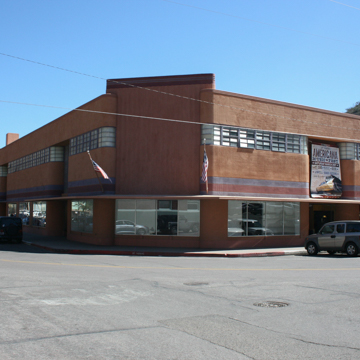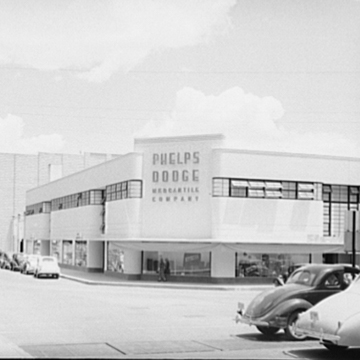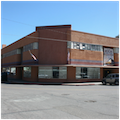Located on the south side of Copper Queen Plaza, in the heart of Bisbee, the building that originally housed the Phelps Dodge Mercantile Company, the retail subsidiary of the larger corporation, was an imposing reminder that this was a company town. The building’s Streamline Moderne style was decidedly au courant in 1939, and while it may have conflicted aesthetically with the more traditional facades of a downtown built primarily between 1890 and 1915, it reflected a moment of corporate optimism as copper prices rebounded in the immediate years leading up to World War II.
Bisbee’s main department store was one of several the Phelps Dodge Mercantile Company built in mining regions across the Southwest, including those in Tyrone and Dawson, New Mexico, and in Douglas and Morenci, Arizona. The Bisbee location was the original, founded in 1886 when the Copper Queen Consolidated Mining Company purchased Mary Crossey’s general store, which it renamed the Copper Queen Mercantile. As an emporium, the Mercantile sold a range of dry goods, from foodstuffs and pharmaceuticals to clothing and home furnishings. In many mining communities, the company store was the only consolidated retail venue for miles, a situation that ensured that miners’ wages would end up in company’s coffers whether workers were paid in hard currency or scrip. This was not the case in Bisbee, which in 1923 boasted thirty independent groceries, six clothing stores, and one other large department store. Whether it was because Phelps Dodge had mercantile origins, because of its corporate philosophy, or because of retail competition, the Bisbee Mercantile apparently stocked high quality and reasonably priced merchandise in a 1910 building attributed to architect Henry C. Trost.
After a devastating fire destroyed that building the site cleared for a new Mercantile designed by the Phoenix-based architectural firm Lescher and Mahoney. Royal W. Lescher (1882–1957) and Leslie J. Mahoney (1892–1985) had already designed a number of Art Deco and Streamline Moderne edifices in and around Phoenix. For Bisbee, they produced a thoroughly modern Mercantile, built of concrete with aluminum detailing. Contractor Del E. Webb (1899–1975), who later developed the retirement community of Sun City, Arizona, was responsible for the Mercantile’s construction.
The unornamented Mercantile has rounded corners, steel-sash ribbon windows, crisp white walls, and a flat roof—standard formal tropes of the popularized modernism of the interwar decades. Intended to be evocative forward movement progress, the building’s sleek profile was very much of the zeitgeist. The two-story building (full height on the interior with a mezzanine level on the perimeter) has recessed entries and plate-glass storefronts shaded by a thin, curving canopy on the first floor; the second floor’s ribbon windows consist of fixed panes and multilight hoppers. The chamfered northwestern corner, where the main entrance is located, is slightly recessed and extended above the roofline to create a vertically ribbed signboard area, which was originally illuminated and displayed the store’s name in sans serif letters. Appropriately for this mining town, the Mercantile was fitted with copper light fixtures, many of which remain. The interior had tinted mirrors and aluminum detailing that introduced a note of sophistication to the shopper’s experience.
The Mercantile’s facade was altered in 1965 and the store was closed in 1976, one year after the Copper Queen Mine was shuttered. Since then, the building’s original signage was removed and it has been painted, most recently with purple and maroon bands above the first-story wraparound awning. The building still houses retail enterprises, which help to keep alive the memory of the Mercantile.
References
Schwantes, Carlos A. Vision and Enterprise: Exploring the History of Phelps Dodge Corporation. Tucson: University of Arizona Press, 2000.
Wilson, Marjorie H., Janet Stewart, James Garrison, Billy G. Garrett, and Thomas S. Rothweiler, “Bisbee Historic District,” Cochise County, Arizona. National Register of Historic Places Registration Form, 1980. National Park Service, U.S. Department of the Interior, Washington, D.C.








